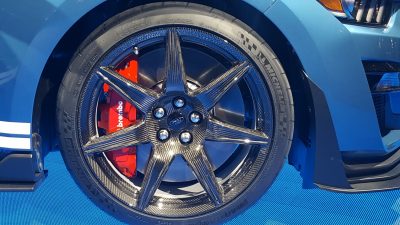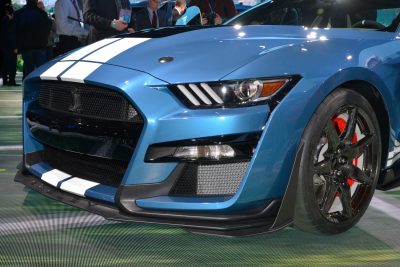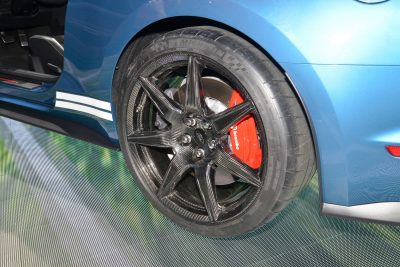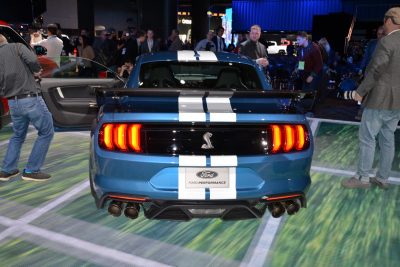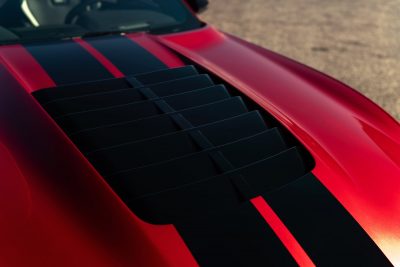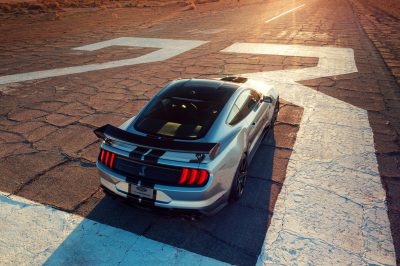In the current iteration of the muscle car wars, the extreme end of the segment has lately been dominated by two distinct entries, the Chevrolet Camaro ZL1 and the 717 Dodge Challenger Hellcat.
Both of these models have been slugging it out in sales and on the racetrack for awhile now, but that’s partially due to the absence of a third contender, the Shelby GT500. The GT500 last terrorized the dragstrip in the mid 2000’s before ending production in 2013. Ford has not forgotten the unique allure of the GT500, and has unleashed the latest GT500 to try and reclaim the ground that the model has lost in recent years.
The newest GT500 is perhaps the wildest interpretation of the iconic breed yet, with bold exterior styling that is even more purposeful than before and was described by longtime Mustang designer Melvin Betacourt describes as the lineup’s “Holy $%&@” car. That expletive is certainly a valid descriptor with the GT500 exuding even more personality than the ZL1, while also managing to out brawn the Challenger Hellcat. the front fascia is all new and features fenders that are made out of a special sheet molding compound (SMC) that has been shaved by 0.4 inch to allow room for the bigger front tires. The already beefy power bulge hood also features SMC construction, and also incorporates a massive vent to help channel excess engine heat out of the engine bay. Simulated hood pins also adorn the hood, and are arguably the only demerit here on the hood (we prefer functional pins) but they do match nicely with the blue paint that adorned the blue example that Ford had ready for photos. The fore-mentioned vent also causes the GT 500 to have an enclosed intake element. A removable rain tray is also included, and the assembly can be puled out for maximum air extraction, or left in on rainy days to reduce water intrusion.
Other desirable touches include full carbon fiber wheels, a massive front splitter, as well as an equally massive rear diffuser that allows the GT500 to further hone its diabolical intentions to passersby. The rear of the GT500 on the other hand is not that radically different from the GT350 with the only major difference being different wing options that buyers can choose for the GT500 versus its other Shelby badged siblings.
The interior of the 2020 Shelby GT500 Mustang also embraces abundant amounts of carbon fiber, and occupants are greeted with supportive thrones that were designed to keep them firmly in place during spirited driving.
The rest of the basic layout is pure Mustang which means that trademarks such as the center console mounted toggle switches and the familiar button layout are carried over largely intact. An Alcantara wrapped steering wheel greets the drivers hands, and like other Mustangs, the GT500 features the trick exhaust system that defines other select iterations of Mustang. Buyers can choose from several different modes, but Ford admitted that the GT500 was only able to pass California’s sound test in Quiet mode which makes us wonder just how loud it indeed is when the system is left in all out track mode.
With the car now largely out in the open, Ford chose to pull one last rabbit out of its hat of tricks, and has not released formal power figures for the V8 engine lurking under the hood. What we do know, is that a 2.7 liter Eaton supercharger will be nestled on top of the engine to help spike the amount of power that is available from the 5.2 liter V8.
The engine shares many of the elements that also make their mark in the lower rung GT350, but in order for it to tuned to its full potential, Ford engineers had to sacrifice the novel flat plane crankshaft, but who needs higher revs, when you have 12 lbs of boost being pumped into the heavily strengthened engine anyway? This special V8 also comes equipped with a cast aluminum structural oil pan that features both static baffles and hinged doors that open and close at high speeds.
Ford claims that this setup eliminates the need for a heavier dry-sump system, and that it also ensures maximum track survivability. A suite of coolers is also outfitted to the Shelby to further enhance track durability, including an air to liquid intercooler on the supercharger, engine and transmission oil coolers, as well as an upgraded radiator.
A key change is that for the first time ever, the 2020 GT500 will pitch its traditional manual transmission layout, and instead embrace an all new seven speed dual clutch automatic transmission that promises to make far better use of the power than the manual ever could.
While this omission might sour the moods of diehard traditionalists that prefer the old three pedal setup, it’s hard to ignore the enormous potential that a DCT brings to the table, especially considering how well this type of transmission has performed in various Volkswagen products over the years, as well as other fire breathing sports cars that have also embraced a DCT. Plus we will not miss the excessively heavy clutch of the old GT500 which felt like your leg was moving a sack of bricks up and down the length of travel before popping the selected gear into place.
The new DCT is a few cogs short of the 10-speed that is equipped to the ZL1, but Ford promises that the DCT can actually change its behavior drastically depending on which drive mode is selected.
Drag mode for instance will force the transmission to deliver shifts with no torque interruption, while Track mode factors in the steering angle of the car as well as other parameters to prevent an abrupt downshift that could potentially destabilize the car in a turn. The transmission can either be left to its own devices in automatic mode, or drivers can take control themselves via steering wheel mounted magnesium shift paddles.
Lastly unlike other GT500s which were more well known for their abilities to be potent straight line missiles versus being track carving weapons, Ford claims that the GT500 can handle going left or right just as well as it can going in a straight line thanks to extensive suspension retuning as well as reworked dampers, stiffer springs, and fatter anti roll bars among other enhancements.
The standard wheels are 20-inch aluminum wheels, but opt for the Carbon Fiber Track Package, and they are replaced with pure carbon fiber wheels shod with Michelin Pilot Sport Cup 2 track tires, package exclusive dive planes, a rear seat delete, and a massive fully adjustable carbon fiber rear wing.
Ford claims that the 2020 GT500 should be able to trounce the ZL1 and the Hellcat when it eventually slithers its way into dealerships.
We also overheard whispers from several Ford execs in the upper rows of chairs at Ford’s press conference that the engine could bring up to 755 horsepower to the party (a figure that could very well change with time) but looking at the numbers listed in our tale of the tape below, it’s evident that the GT500 brings very potent firepower and track ready performance to the high performance muscle car segment.
By the Numbers*
*Final horsepower, torque and performance stats available summer 2019.

Tom Burkart is the founder and managing editor of Car-Revs-Daily.com, an innovative and rapidly-expanding automotive news magazine.
He holds a Journalism JBA degree from the University of Wisconsin – Madison. Tom currently resides in Charleston, South Carolina with his two amazing dogs, Drake and Tank.
Mr. Burkart is available for all questions and concerns by email Tom(at)car-revs-daily.com.




